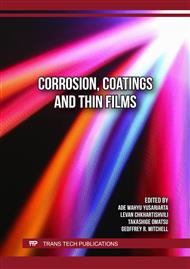p.3
p.13
p.23
p.35
p.47
p.55
p.67
p.73
p.79
Dry Reciprocating Wear and Friction Behavior of HVOF Sprayed NiCrBSi-TiB2 Coating
Abstract:
Thermally sprayed NiCrBSi alloys have attracted interest in various fields of protective coating applications due to their good properties, especially for wear and corrosion resistance. Titanium diboride (TiB2) is an attractive additive particle because of its properties such as high hardness, high melting point, high chemical resistance, high elastic modulus and low density. In this work, the effect of TiB2 on dry reciprocating wear behavior of NiCrBSi-TiB2 coating was systematically studied. NiCrBSi alloy powder was mixed with 15, 20, and 25 wt.% TiB2 powder. Subsequently, mixed powder was coated on the substrate of 316L stainless steel (∅20 mm and 5 mm thickness) by High Velocity Oxygen Fuel (HVOF) technique. The microstructure of the coating was investigated under an optical microscope and scanning electron microscope (SEM). The hardness of the coating was measured by microhardness. In addition, dry sliding friction and wear behavior of coating were performed on a reciprocating ball-on-flat wear tester machine. The high-chromium steel (AISI 52100) ball of 6 mm in diameter was used as the counterpart. The conditions of the tests were 8 mm in stroke, 1 and 2 Hz in testing frequency with 10 N load, and sliding distance of 100 m. The variation of friction coefficient was recorded during the tests. The results indicated that an increase in TiB2 content within the coating led to the formation of dark gray phases, oxidation layers and porosities in the microstructure. Consequently, reduction in the coating's hardness and wear resistance were discovered. In addition, the addition of TiB2 in the NiCrBSi coating resulted in the higher material loss on the counterface ball due to abrasive wear mechanism.
Info:
Periodical:
Pages:
47-54
Citation:
Online since:
October 2025
Keywords:
Price:
Сopyright:
© 2025 Trans Tech Publications Ltd. All Rights Reserved
Share:
Citation:


